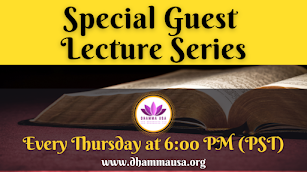Buddhism andReligious Harmony: An Exploration through Pali Suttas
By Dr. Nivitigala Sumitta Thero (Bhante Sumitta)
Buddhism promotes religious harmony through its foundational principles of non-harm, respect for diverse paths, and the cultivation of compassion. Central to this approach are the teachings found in the Pali Canon, such as the Dhammapada, which underscores the importance of non-violence towards all beings, and the Kalama Sutta, which encourages personal discernment over dogmatic adherence. The Metta Sutta further emphasizes boundless loving-kindness towards everyone, transcending religious differences. By embodying these principles, Buddhists are guided to engage respectfully with individuals of all faiths, fostering peaceful coexistence and mutual understanding.
Buddhism, a major world religion founded by Siddhartha Gautama—the Buddha—in the 5th to 4th century BCE, is deeply intertwined with the concept of religious harmony. Central to Buddhism's teachings is the principle of non-harm, or ahimsa, which extends beyond one's interactions with individuals to encompass broader interfaith relations. The Pali Canon, one of the earliest and most comprehensive collections of Buddhist scriptures, provides insightful guidance on this subject. This essay explores how Buddhism fosters religious harmony, drawing upon various Pali suttas to highlight its foundational principles.
Foundations of Religious Harmony in Buddhism
The concept of religious harmony in Buddhism is closely related to the practice of compassion (karuṇā), loving-kindness (mettā), and equanimity (upekkhā). These qualities are crucial for maintaining peaceful coexistence among diverse religious traditions. The Buddha's teachings consistently emphasize understanding and respecting others’ paths as a means of fostering harmony.
The Principle of Non-Harm
A fundamental principle in Buddhism is non-harm, or ahimsa, which is critical for achieving harmony. The Buddha's teachings on non-harm are evident in the Dhammapada, where he says:
“All tremble at violence; all fear death. Comparing others with oneself, one should neither kill nor cause to kill.”^1
This principle encourages followers to extend compassion and respect not only to fellow Buddhists but to all beings, regardless of their faith or beliefs.
Respect for Different Paths
The Kalama Sutta, one of the most well-known Pali suttas, illustrates the Buddha’s approach to religious pluralism. In this sutta, the Buddha advises the Kalamas, a group of people uncertain about which teachings to follow:
“Do not go upon what has been acquired by repeated hearing; nor upon tradition; nor upon rumor; nor upon what is in a scripture; nor upon surmise; nor upon an axiom; nor upon specious reasoning; nor upon a bias toward a notion that has been pondered over; nor upon another’s seeming ability; nor upon the consideration, ‘The monk is our teacher.’”^2
Instead, he encourages them to investigate teachings themselves and follow those that lead to welfare and happiness. This advice underscores a respect for different paths and emphasizes personal experience and discernment over dogmatic adherence.
The Importance of Understanding and Compassion
The Metta Sutta emphasizes the importance of loving-kindness as a means of fostering harmonious relationships:
“Just as a mother would protect her only child with her life, even so, let him cultivate a boundless heart toward all living beings.”^3
This sutta advocates for an unconditional and expansive love that transcends religious boundaries, suggesting that true compassion involves caring for all sentient beings, regardless of their religious affiliations.
Practical Applications of Buddhist Principles in Promoting Religious Harmony
Buddhist principles offer practical guidance for promoting religious harmony in diverse settings. For instance, the emphasis on non-harm encourages Buddhists to engage respectfully with people of other faiths and to actively seek common ground. This is reflected in the Buddha’s instructions to his followers to:
“Speak in a way that is gentle, kind, and free from aversion or ill-will, and to speak only the truth.”^4
Such conduct fosters positive interactions and builds mutual respect among different religious groups.
Furthermore, the practice of meditation and mindfulness in Buddhism can lead to greater empathy and understanding, which are essential for interfaith dialogue. The Buddha’s teachings on equanimity suggest maintaining a balanced perspective in the face of differing beliefs:
“One who is free from hatred and delusion, whose mind is not troubled by greed and anger, such a person’s mind is serene.”^5
This serenity can facilitate more meaningful and respectful discussions between individuals of different faiths.
Conclusion
Buddhism’s commitment to non-harm, respect for different paths, and the cultivation of compassion and understanding provides a robust framework for fostering religious harmony. The Pali suttas, including the Dhammapada, Kalama Sutta, and Metta Sutta, offer valuable insights into how Buddhists can interact with others in a manner that promotes peace and mutual respect. By embracing these teachings, individuals can contribute to a more harmonious and inclusive world.
References
Dhammapada, v. 130.
Kalama Sutta, Anguttara Nikaya 3.65.
Metta Sutta, Sutta Nipata 1.8.
Sutta Nipata, v. 15.
Majjhima Nikaya, 1.31.

.jpg)






























0 comments:
Post a Comment
Your comments and feedback are very helpful to us in improving our posts. We really appreciate your time. Thank you!
Dhamma USA Team.